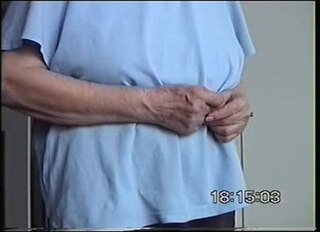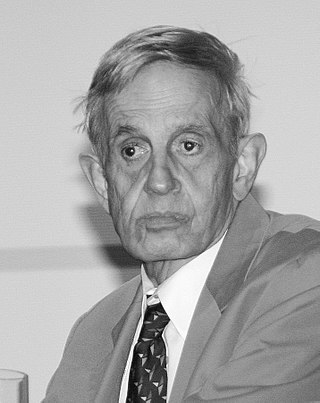Related Research Articles

Antipsychotics, previously known as neuroleptics and major tranquilizers, are a class of psychotropic medication primarily used to manage psychosis, principally in schizophrenia but also in a range of other psychotic disorders. They are also the mainstay, together with mood stabilizers, in the treatment of bipolar disorder. Moreover, they are also used as adjuncts in the treatment of treatment-resistant major depressive disorder.
Psychosis is a condition of the mind that results in difficulties determining what is real and what is not real. Symptoms may include delusions and hallucinations, among other features. Additional symptoms are incoherent speech and behavior that is inappropriate for a given situation. There may also be sleep problems, social withdrawal, lack of motivation, and difficulties carrying out daily activities. Psychosis can have serious adverse outcomes.
Schizophrenia is a mental disorder characterized by reoccurring episodes of psychosis that are correlated with a general misperception of reality. Other common signs include hallucinations, delusions, disorganized thinking and behavior, social withdrawal, and flat or inappropriate affect. Symptoms develop gradually and typically begin during young adulthood and are never resolved. There is no objective diagnostic test; diagnosis is based on observed behavior, a psychiatric history that includes the person's reported experiences, and reports of others familiar with the person. For a diagnosis of schizophrenia, the described symptoms need to have been present for at least six months or one month. Many people with schizophrenia have other mental disorders, especially substance use disorders, depressive disorders, anxiety disorders, and obsessive–compulsive disorder.

Clozapine is a psychiatric medication and was the first atypical antipsychotic to be discovered. It is primarily used to treat people with schizophrenia and schizoaffective disorder who have had an inadequate response to two other antipsychotics, or who have been unable to tolerate other drugs due to extrapyramidal side effects. It is also used for the treatment of psychosis in Parkinson's disease.

A mood disorder, also known as an affective disorder, is any of a group of conditions of mental and behavioral disorder where a disturbance in the person's mood is the main underlying feature. The classification is in the Diagnostic and Statistical Manual of Mental Disorders (DSM) and International Classification of Diseases (ICD).
A psychiatric or psychotropic medication is a psychoactive drug taken to exert an effect on the chemical makeup of the brain and nervous system. Thus, these medications are used to treat mental illnesses. These medications are typically made of synthetic chemical compounds and are usually prescribed in psychiatric settings, potentially involuntarily during commitment. Since the mid-20th century, such medications have been leading treatments for a broad range of mental disorders and have decreased the need for long-term hospitalization, thereby lowering the cost of mental health care. The recidivism or rehospitalization of the mentally ill is at a high rate in many countries, and the reasons for the relapses are under research.

Fluphenazine, sold under the brand name Prolixin among others, is a high-potency typical antipsychotic medication. It is used in the treatment of chronic psychoses such as schizophrenia, and appears to be about equal in effectiveness to low-potency antipsychotics like chlorpromazine. It is given by mouth, injection into a muscle, or just under the skin. There is also a long acting injectable version that may last for up to four weeks. Fluphenazine decanoate, the depot injection form of fluphenazine, should not be used by people with severe depression.

Typical antipsychotics are a class of antipsychotic drugs first developed in the 1950s and used to treat psychosis. Typical antipsychotics may also be used for the treatment of acute mania, agitation, and other conditions. The first typical antipsychotics to come into medical use were the phenothiazines, namely chlorpromazine which was discovered serendipitously. Another prominent grouping of antipsychotics are the butyrophenones, an example of which is haloperidol. The newer, second-generation antipsychotics, also known as atypical antipsychotics, have largely supplanted the use of typical antipsychotics as first-line agents due to the higher risk of movement disorders in the latter.

The atypical antipsychotics (AAP), also known as second generation antipsychotics (SGAs) and serotonin–dopamine antagonists (SDAs), are a group of antipsychotic drugs largely introduced after the 1970s and used to treat psychiatric conditions. Some atypical antipsychotics have received regulatory approval for schizophrenia, bipolar disorder, irritability in autism, and as an adjunct in major depressive disorder.

Risperidone, sold under the brand name Risperdal among others, is an atypical antipsychotic used to treat schizophrenia and bipolar disorder. It is taken either by mouth or by injection. The injectable versions are long-acting and last for 2–4 weeks.

Akathisia is a movement disorder characterized by a subjective feeling of inner restlessness accompanied by mental distress and an inability to sit still. Usually, the legs are most prominently affected. Those affected may fidget, rock back and forth, or pace, while some may just have an uneasy feeling in their body. The most severe cases may result in poor adherence to medications, exacerbation of psychiatric symptoms, and, because of this, aggression, violence, and/or suicidal thoughts. Akathisia is also associated with threatening behaviour and physical aggression in mentally disordered patients. However, the attempts to find potential links between akathisia and emerging suicidal or homicidal behaviour were not systematic and were mostly based on a limited number of case reports and small case series. Apart from these few low-quality studies, there is another more recent and better quality study that concludes akathisia cannot be reliably linked to the presence of suicidal behaviour in patients treated with antipsychotic medication.
Schizoaffective disorder is a mental disorder characterized by abnormal thought processes and an unstable mood. This diagnosis requires symptoms of both schizophrenia and a mood disorder: either bipolar disorder or depression. The main criterion is the presence of psychotic symptoms for at least two weeks without any mood symptoms. Schizoaffective disorder can often be misdiagnosed when the correct diagnosis may be psychotic depression, bipolar I disorder, schizophreniform disorder, or schizophrenia. This is a problem as treatment and prognosis differ greatly for most of these diagnoses.

Perphenazine is a typical antipsychotic drug. Chemically, it is classified as a piperazinyl phenothiazine. Originally marketed in the United States as Trilafon, it has been in clinical use for decades.
A major depressive episode (MDE) is a period characterized by symptoms of major depressive disorder. Those affected primarily exhibit a depressive mood for at least two weeks or more, and a loss of interest or pleasure in everyday activities. Other symptoms can include feelings of emptiness, hopelessness, anxiety, worthlessness, guilt, irritability, changes in appetite, difficulties in concentration, difficulties remembering details, making decisions, and thoughts of suicide. Insomnia or hypersomnia and aches, pains, or digestive problems that are resistant to treatment may also be present.
The emphasis of the treatment of bipolar disorder is on effective management of the long-term course of the illness, which can involve treatment of emergent symptoms. Treatment methods include pharmacological and psychological techniques.
Extrapyramidal symptoms (EPS) are symptoms that are archetypically associated with the extrapyramidal system of the brain's cerebral cortex. When such symptoms are caused by medications or other drugs, they are also known as extrapyramidal side effects (EPSE). The symptoms can be acute (short-term) or chronic (long-term). They include movement dysfunction such as dystonia, akathisia, parkinsonism characteristic symptoms such as rigidity, bradykinesia, tremor, and tardive dyskinesia. Extrapyramidal symptoms are a reason why subjects drop out of clinical trials of antipsychotics; of the 213 (14.6%) subjects that dropped out of one of the largest clinical trials of antipsychotics, 58 (27.2%) of those discontinuations were due to EPS.
Bipolar II disorder (BP-II) is a mood disorder on the bipolar spectrum, characterized by at least one episode of hypomania and at least one episode of major depression. Diagnosis for BP-II requires that the individual must never have experienced a full manic episode. Otherwise, one manic episode meets the criteria for bipolar I disorder (BP-I).

A persecutory delusion is a type of delusional condition in which the affected person believes that harm is going to occur to oneself by a persecutor, despite a clear lack of evidence. The person may believe that they are being targeted by an individual or a group of people. Persecution delusions are very diverse in terms of content and vary from the possible, although improbable, to the completely bizarre. The delusion can be found in various disorders, being more usual in psychotic disorders.

The prognosis of schizophrenia is varied at the individual level. In general it has great human and economics costs. It results in a decreased life expectancy of 12–15 years primarily due to its association with obesity, little exercise, and smoking, while an increased rate of suicide plays a lesser role. These differences in life expectancy increased between the 1970s and 1990s, and between the 1990s and 2000s. This difference has not substantially changed in Finland for example – where there is a health system with open access to care.
Schizophrenia is a primary psychotic disorder, whereas, bipolar disorder is a primary mood disorder which can also involve psychosis. Both schizophrenia and bipolar disorder are characterized as critical psychiatric disorders in the Diagnostic and Statistical Manual of Mental Disorders fifth edition (DSM-5). However, because of some similar symptoms, differentiating between the two can sometimes be difficult; indeed, there is an intermediate diagnosis termed schizoaffective disorder.
References
- 1 2 3 4 5 Mulholland, Ciaran; Cooper, Stephen (1 May 2000). "The symptoms of depression in schizophrenia and its management". Advances in Psychiatric Treatment. 6 (3): 169–177. doi: 10.1192/apt.6.3.169 .
- ↑ Jeczmien, P; Levkovitz, Y; Weizman, A; Carmel, Z (August 2001). "Post-psychotic depression in schizophrenia". The Israel Medical Association Journal. 3 (8): 589–92. PMID 11519384.
- 1 2 3 "Post-schizophrenic depression". Annales Médico-Psychologiques. Jun 1975.
- 1 2 Ivanets, NN; Kinkul'kina, MA (2008). "Depression in schizophrenia". Vestnik Rossiiskoi Akademii Medistinskikh Nauk (10): 55–63. PMID 19140400.
- 1 2 The ICD-10 Classification of Mental and Behavioural Disorders. World Health Organization.
- 1 2 Nordt, C.; Rossler, W.; Lauber, C. (2006). "Attitudes of mental health professionals toward people with schizophrenia and major depression". Schizophrenia Bulletin. 32 (4): 709–714. doi:10.1093/schbul/sbj065. PMC 2632277 . PMID 16510695.
- ↑ Crisp, Arthur H.; Gelder, Michael G.; Rix, Susannah; Meltzer, Howard I.; Rowlands, Olwen J. (July 2000). "Stigmatisation of people with mental illnesses". The British Journal of Psychiatry. 177: 4–7. doi: 10.1192/bjp.177.1.4 . PMID 10945080.
- ↑ Mauri, MC; Volonteri, LS; De Gaspari, IF; Colasanti, A; Brambilla, MA; Cerruti, L (2006). "Substance abuse in first-episode schizophrenic patients: A retrospective study". Clinical Practice and Epidemiology in Mental Health. 2: 4. doi: 10.1186/1745-0179-2-4 . PMC 1435752 . PMID 16556300.
- ↑ "Outpatient maintenance of chronic schizophrenic patients with long-term fluphenazine: double-blind placebo trial". British Medical Journal. 1973.
- 1 2 "Dysphoric and depressive symptoms in chronic schizophrenia". Schizophrenia Research. 1989.
- ↑ Johnson, D. (1981). "Studies of depressive symptoms in schizophrenia". British Journal of Psychiatry. 139 (2): 89–101. doi:10.1192/bjp.139.2.89. PMID 7030447. S2CID 21044268.
- ↑ Schwartz-Stav, Osnat (7 April 2006). "Depressive, suicidal behaviour and insight in adolescents with schizophrenia". European Child & Adolescent Psychiatry. 15 (6): 352–359. doi:10.1007/s00787-006-0541-8. PMID 16604378. S2CID 6404420.
- 1 2 Samuel, Siris (August 2012). "Treating 'depression' in patients with schizophrenia". Current Psychiatry.
- 1 2 Hawton, Keith; Sutton, Lesley; Haw, Camilla; Sinclair, Julia; Deeks, Jonathan J. (June 2005). "Schizophrenia and suicide: systematic review of risk factors". The British Journal of Psychiatry. 187: 9–20. doi: 10.1192/bjp.187.1.9 . PMID 15994566.